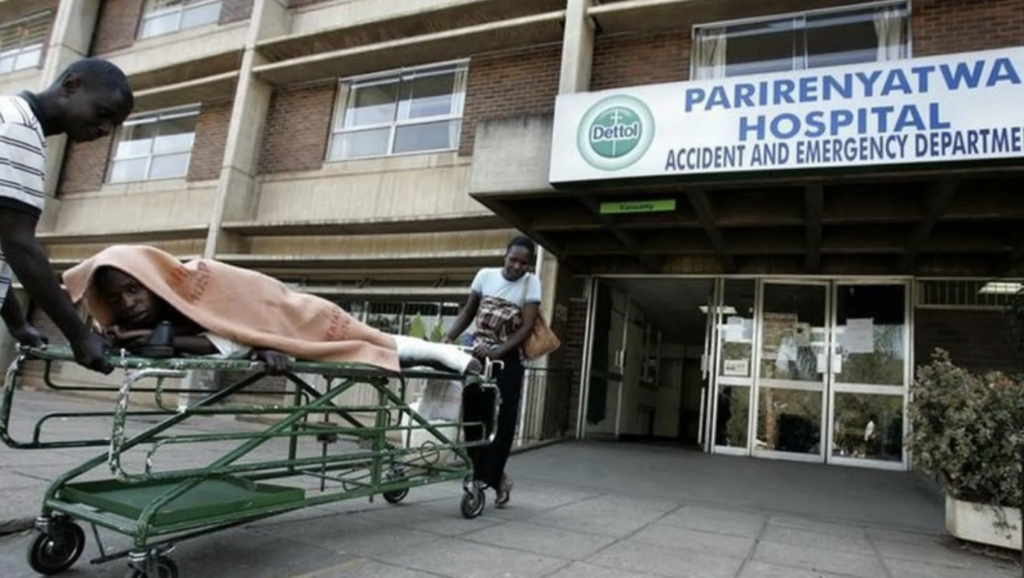The collapse of Zimbabwe’s healthcare system has left a trail of devastation in its wake. Once a beacon of hope and a model for other African countries, the healthcare system has deteriorated alarmingly. Hospitals lack basic medical supplies, equipment, and staff, leaving patients to suffer and die from treatable conditions. The personal toll of this collapse is immeasurable, with families torn apart by preventable deaths and livelihoods destroyed by high medical bills. This blog explores the individual impact of Zimbabwe’s healthcare collapse, delving into the stories of those affected and the factors that led to this crisis.
In 1980, Zimbabwe’s independence brought promise of a robust healthcare system built on principles of equity and universal primary care. The country even achieved commendable milestones, boasting a healthcare system that was enviable to many. However, the introduction of the Economic Structural Adjustment Programme (ESAP) in the 1990s marked a turning point, birthing inequalities that would haunt the system for decades. The Economic Structural Adjustment Programme (ESAP) had a devastating impact on Zimbabwe’s health sector, which included:
- Reduced Healthcare Funding by the Government: ESAP led to decreased government spending on healthcare, affecting the availability and quality of public healthcare,
- Increasing Healthcare Costs: to cover the funding gap, the government introduced user fees, making healthcare less affordable for most Zimbabweans
- Brain Drain: Low funding and poor working conditions drove healthcare professionals to seek opportunities elsewhere and
- Decreased Access to Healthcare: ESAP reforms disrupted the Primary Health Care (PHC) concept, which aimed to provide equitable healthcare service.

Some efforts were made to revamp the system that was heavily affected by ESAP. These included the National Health Strategy of Zimbabwe (1997-2007) which emphasized working for quality and equity in health. Results-Based Financing Policy (RBF) – This initiative aimed to improve healthcare outcomes by providing financial incentives to healthcare providers based on performance. RBF has been instrumental in promoting quality healthcare, particularly in maternal and child health. The National AIDS Trust Fund (NATF) was established to address the HIV/AIDS epidemic. This innovative financing model enabled the government to allocate resources specifically for HIV prevention and treatment, thereby addressing one of the major public health challenges exacerbated by ESAP. By leveraging domestic resources, the NATF helped reduce Zimbabwe’s reliance on external aid and mitigated the negative effects of ESAPs on the healthcare system.
Fluctuations in the Zimbabwe Healthcare Systems
Zimbabwe’s healthcare system is marred by stark inequalities, perpetuated by the existence of two parallel healthcare structures: well-funded private hospitals and under-resourced public hospitals. This dichotomy creates a stark divide between the ‘haves’ and ‘have-nots’, where access to quality healthcare is determined by one’s financial means.
On one hand, private hospitals offer good quality facilities and services, catering to those who can afford premium healthcare. These hospitals are equipped with modern equipment, skilled staff, and adequate resources, providing a comfortable and efficient healthcare experience for their patients. On the other hand, public hospitals struggle with inadequate resources, outdated equipment, and insufficient staff. These hospitals are often overcrowded and underfunded, leaving patients to face long queues, limited access to basic medical supplies, and suboptimal care. The situation is particularly dire for vulnerable populations, such as pregnant mothers, who are expected to bring their essential items, like gloves, razor blades, and sheets, to facilitate their care. In 2015, Mpilo Hospital suspended surgical procedures due to a critical shortage of drugs and operating consumables. Patients and health officials reported a lack of basics like bandages and cotton wool swabs. The challenges at the institution escalated in 2024 when 280 child deaths were recorded over 4 months. Hospital sources revealed that the Hospital is grappling with severe resource shortages including lack of medical equipment.
According to statistics Parirenyatwa Hospital’s dialysis machine shortage – with 50% out of service – has resulted in compromised care for around 130 critically ill kidney patients, underscoring the need for adequate healthcare resources


I would like to give an example of how the healthcare system is affecting lives by giving a personal account of losing a loved one. I’ve witnessed the devastating consequences of Zimbabwe’s healthcare disparities firsthand. My sister’s tragic experience is etched in my memory. After a severe accident, she was rushed to Masvingo General Hospital, where her spinal complications warranted urgent attention. However, the hospital’s limited resources and overcrowded conditions meant she received only basic pain management and no oxygen therapy, despite her asthma condition. The lack of adequate care was alarming. We transferred her to Harare Central Hospital (the second largest public Hospital in Zimbabwe), but even there, we were told to procure our medical equipment for her surgery, which would only happen after a three-week wait. The delay would prove fatal given the severity of her injury. Desperate for timely intervention, we scoured for funds to transfer her to a private hospital, where she finally received the urgent attention, she needed. Tragically, she succumbed to her injuries a week later. The what-ifs still haunt me – what if she had received immediate attention? What if the public hospitals had the resources to treat her promptly? Her death was a harsh reminder of the human cost of Zimbabwe’s healthcare crisis, where access to quality care is a privilege reserved for the few who can afford it.
This stark contrast between private and public healthcare in Zimbabwe perpetuates health inequalities, where those who can afford it receive superior care, while the majority of the population is left to navigate an under-resourced and overburdened public healthcare system. We have seen the desire for healthcare service delivery to improve in Zimbabwe Citizens have consistently scored health delivery as an important expectation of the government in our annual Citizens and Expectations Survey (a survey of 1,200 Zimbabweans about what the central government should prioritise). In fact, in the last survey we carried out in 2023 health delivery was third ranked issue on the list of priorities for Zimbabwean citizens. behind unemployment and corruption. Addressing these disparities is crucial to ensuring equitable access to quality healthcare for all Zimbabweans, regardless of their financial means.
The government has made some but not sufficient attempts to address the challenges. In terms of healthcare infrastructure, since 1980, over 65 provincial and district hospitals have been constructed across the country by April 2024. This presented a ratio of 1.6 health facilities per 10000 people, while according to the National Health Strategy of 2021-2025, the national ratio should be 11 health facilities for every 10000 people This has proved insufficient to meet the needs of citizens. Renovations have been undertaken on existing infrastructure, including installing solar systems and sinking boreholes to ensure constant water and electricity supply. By 2022 over 1,000 public health facilities across the country had received access to solar energy through the government program designed to provide electricity backup power at all health centres in the country. In October 2023 the country acquired new machinery and equipment in the form of MRI machines for Mpilo and Parirenyatwa hospitals in Bulawayo and Harare respectively. This after several outcries by citizens over the deteriorating situation in the public health sector. Before this, the situation was so bad that MRI scan services were only available in private hospitals costing at least US$500.00 per scan, a cost many could not afford.
Cholera outbreaks have been another major health challenge. Despite efforts to secure funding for treatment, the disease has claimed several lives. The most recent outbreak led to a state of emergency being declared in November 2023, followed by a vaccination campaign. By March 2024, nearly 29,000 cholera cases and 603 deaths were recorded across the country. The previous cholera outbreak in 2019 claimed 68 lives, the lives claimed were much lower than the largest and deadliest cholera outbreak in Zimbabwe 2008/2009 which claimed more than 4000 lives.
Training of health personnel has also been notable in the country, although the country still faces a shortage of doctors. There has been a notable increase in strikes by nurses and doctors over low remuneration, leading to a skills migration crisis. In response, the government enacted the Health Service Amendment Act in 2023 banning prolonged strikes by health workers, but this only escalated the situation. Statistics show that between September 2022 and September 2023, over 21,000 Zimbabweans, mostly nurses and care workers, sought and were granted visas to work in the United Kingdom. According to the Zimbabwe Medical Association, the country has a paltry 3500 doctors for a population of 15 million, resulting in a ratio of 0.91 doctors per 1000 inhabitants. The worldwide average ratio is 1.70 doctors per 1000 inhabitants. Zimbabwe’s doctor-to-population ratio is 9 times lower than the global average. This calls for an intervention to help with staffing issues.
A glimpse of hope has been recorded as Zimbabwe’s infant mortality rate has shown a significant decline in recent years. With a rate of 33.406 deaths per 1000 live births in 2024, this represents a 2.02% decrease from 2023’s rate of 34.096 deaths per 1000 live births. This downward trend is consistent with the previous year’s decline of 2.65% from 2022. The improvement indicates that Zimbabwe is making progress in reducing infant mortality, which is a crucial indicator of a country’s overall health and well-being. Several factors could be contributing to this decline, including improved sanitation, and increased vaccination rates.
On the other hand, Zimbabwe’s life expectancy has fluctuated over the years, influenced by various factors. In 2022, the country ranks 116th out of 194 countries in terms of life expectancy. During the same year, the life expectancy for Zimbabwe was 61.89 years, a 0.43% increase from 2021. The increase suggests a modest increase in health outcomes. However, Zimbabwe’s life expectancy remains lower than the global average of 71.1 years in 2021 and regional averages for instance South Africa with 69.3 years and Botswana with 69.1 years. Moreover, despite being a signatory to the Abuja Declaration, Zimbabwe’s total budget for the healthcare sector remains below the stipulated 15% of its national budget. By not meeting this target, Zimbabwe’s healthcare system faces serious challenges, including inadequate funding, insufficient medical supplies, and a shortage of healthcare professionals. The country’s health budget has been consistently below the recommended 15%, with only 11% allocated to the health and childcare ministry in 2023 and 9% in 2024
Conclusion
The weakening of Zimbabwe’s healthcare system is a tragic tale of broken promises and shattered dreams. From the early days of independence to the present, the system has been ravaged by policy changes and economic instability. The personal and corporate toll is immeasurable, with countless lives lost and families torn apart. Statistics have shown on the one hand a slight increase in the healthcare system of Zimbabwe and on the other hand a decrease even compared to regional and global averages. These call for an improved system to support Zimbabwean citizens. To accelerate this transformation Zimbabwe could look into:
1. Increase National investment in primary healthcare: Strengthening primary healthcare facilities and services can help prevent illnesses, reduce the burden on tertiary hospitals, and improve health outcomes. This can be achieved through targeted funding, staff training, and infrastructure development.
2. Foster public-private partnerships: Collaborations between government, private sector, and organizations can help bridge the resource gap, introduce innovative solutions, and enhance service delivery. This can include partnerships for equipment provision, staff training, and healthcare infrastructure development.
It is time for the government, healthcare professionals, and the international community to come together to revive Zimbabwe’s healthcare system. We owe it to the people of Zimbabwe to restore the promise of quality healthcare, to rebuild trust, and to ensure that no one dies from preventable causes. The journey ahead will be long and arduous, but with collective effort, we can turn the tide of despair into a new era of hope and healing.
